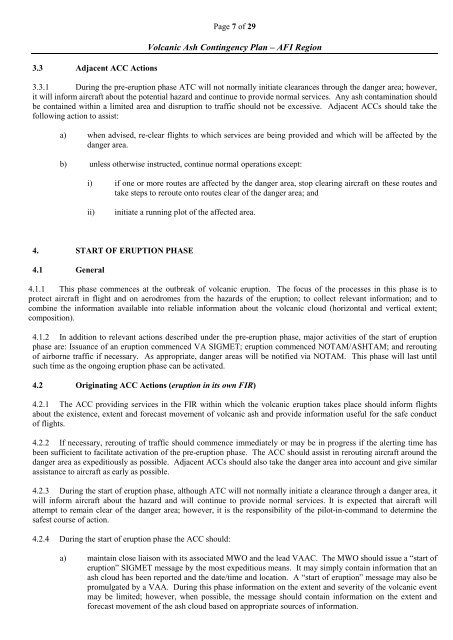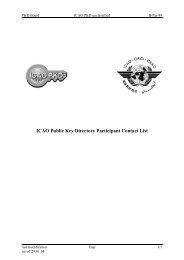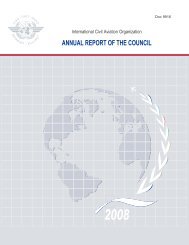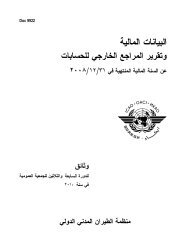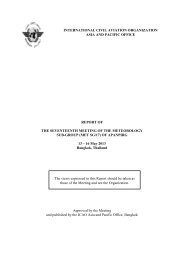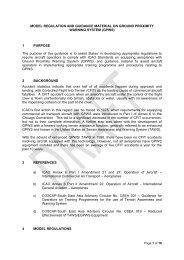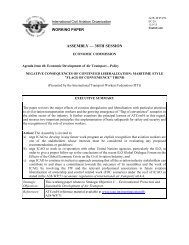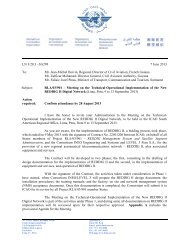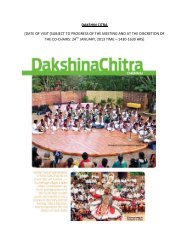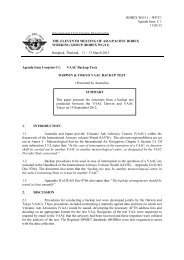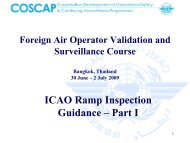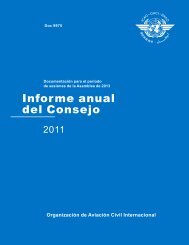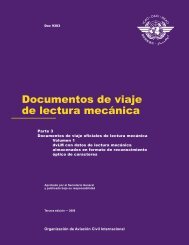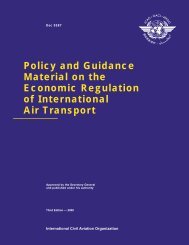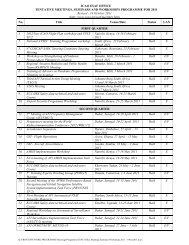afi met bulletins exchange (ambex) handbook - ICAO
afi met bulletins exchange (ambex) handbook - ICAO
afi met bulletins exchange (ambex) handbook - ICAO
Create successful ePaper yourself
Turn your PDF publications into a flip-book with our unique Google optimized e-Paper software.
3.3 Adjacent ACC Actions<br />
Page 7 of 29<br />
Volcanic Ash Contingency Plan – AFI Region<br />
3.3.1 During the pre-eruption phase ATC will not normally initiate clearances through the danger area; however,<br />
it will inform aircraft about the potential hazard and continue to provide normal services. Any ash contamination should<br />
be contained within a limited area and disruption to traffic should not be excessive. Adjacent ACCs should take the<br />
following action to assist:<br />
a) when advised, re-clear flights to which services are being provided and which will be affected by the<br />
danger area.<br />
b) unless otherwise instructed, continue normal operations except:<br />
i) if one or more routes are affected by the danger area, stop clearing aircraft on these routes and<br />
take steps to reroute onto routes clear of the danger area; and<br />
ii) initiate a running plot of the affected area.<br />
4. START OF ERUPTION PHASE<br />
4.1 General<br />
4.1.1 This phase commences at the outbreak of volcanic eruption. The focus of the processes in this phase is to<br />
protect aircraft in flight and on aerodromes from the hazards of the eruption; to collect relevant information; and to<br />
combine the information available into reliable information about the volcanic cloud (horizontal and vertical extent;<br />
composition).<br />
4.1.2 In addition to relevant actions described under the pre-eruption phase, major activities of the start of eruption<br />
phase are: Issuance of an eruption commenced VA SIGMET; eruption commenced NOTAM/ASHTAM; and rerouting<br />
of airborne traffic if necessary. As appropriate, danger areas will be notified via NOTAM. This phase will last until<br />
such time as the ongoing eruption phase can be activated.<br />
4.2 Originating ACC Actions (eruption in its own FIR)<br />
4.2.1 The ACC providing services in the FIR within which the volcanic eruption takes place should inform flights<br />
about the existence, extent and forecast movement of volcanic ash and provide information useful for the safe conduct<br />
of flights.<br />
4.2.2 If necessary, rerouting of traffic should commence immediately or may be in progress if the alerting time has<br />
been sufficient to facilitate activation of the pre-eruption phase. The ACC should assist in rerouting aircraft around the<br />
danger area as expeditiously as possible. Adjacent ACCs should also take the danger area into account and give similar<br />
assistance to aircraft as early as possible.<br />
4.2.3 During the start of eruption phase, although ATC will not normally initiate a clearance through a danger area, it<br />
will inform aircraft about the hazard and will continue to provide normal services. It is expected that aircraft will<br />
attempt to remain clear of the danger area; however, it is the responsibility of the pilot-in-command to determine the<br />
safest course of action.<br />
4.2.4 During the start of eruption phase the ACC should:<br />
a) maintain close liaison with its associated MWO and the lead VAAC. The MWO should issue a “start of<br />
eruption” SIGMET message by the most expeditious means. It may simply contain information that an<br />
ash cloud has been reported and the date/time and location. A “start of eruption” message may also be<br />
promulgated by a VAA. During this phase information on the extent and severity of the volcanic event<br />
may be limited; however, when possible, the message should contain information on the extent and<br />
forecast movement of the ash cloud based on appropriate sources of information.


